Abstract
Malaxis engelsii is a newly discovered orchid found in the upper montane forests of the Atlantic Rainforest in Paraná, Brazil. This species is characterized by its small size, elliptic leaves, flowers with partially connate sepals at the base, trilobate lip with four cavities, and a longitudinal keel on the adaxial surface of the lip apex. A detailed description, photographs, drawings, and comparison with similar species, Malaxis cipoensis, M. sertulifera, and M. ybytus, are provided. Currently, it is classified according to the IUCN guidelines as “Endangered (EN)’’.
Keywords: Cloud Forest; Epiphytism; Montane forest; New species; Orchid; Taxonomy
Resumo
Malaxis engelsii é uma orquídea recém-descoberta encontrada nas florestas alto-montanas da Mata Atlântica no Paraná, Brasil. Esta espécie é caracterizada por seu pequeno porte, folhas elípticas, flores com sépalas parcialmente conadas, labelo trilobado com quatro cavidades e uma quilha longitudinal na superfície adaxial do ápice do labelo. Uma descrição detalhada, fotografias, ilustração e comparação com espécies similares, Malaxis cipoensis, M. sertulifera e M. ybytus, são fornecidas. Atualmente, está classificada de acordo com as diretrizes da IUCN como “Em Perigo (EN)’’.
Palavras-chave: Epifitismo; Floresta Montana; Floresta Nebulosa; Nova espécie; Orquídea; Taxonomia
Introduction
Malaxis Sol. ex Sw. (Swartz 1788) belongs to the subtribe Malaxidinae Benth. & Hook.f. (Bentham & Hooker 1883) and has traditionally been regarded as a cosmopolitan genus, encompassing over 300 species across the Americas, Asia, and Europe (Cribb 2005). The application of molecular studies has led to reevaluating the subtribal taxonomy (Cameron 2005). Additionally, the existing classification system within Malaxis fails to arrange species based on their evolutionary lineages, and the distribution of this genus is probably primarily limited to the Americas, with only a few species extending into the temperate regions of Eurasia (Radins et al. 2014).
The upper montane forest ecosystems of the Floresta Ombrófila Densa Altomontana (Montane Dense Rainforest), also known as Cloud Forest, are marked by their hydrophilic nature. This is attributed to several characteristics, but primarily due to the persistent presence of clouds at higher elevations on mountains (Bruijnzeel & Hamilton 2000). Within these upper montane ridges, the forest exhibits a singular vertical stratum composed of small-sized trees (Leigh 1975). As a result of the perpetual humidity, these trees provide a habitat for an abundance of epiphytes (Blum et al. 2011, Leigh 1975).
In Brazil, ten species of Malaxis are registered within the country’s territory (Smidt & Santos 2023). However, an ongoing genus revision is revealing new species, indicating that the diversity of Malaxis may be underestimated (Santos & Smidt 2023).
A previously undescribed epiphytic Malaxis was discovered by examining the collected material from an expedition to the upper montane forests of the Ibitiraquire mountain range. Consequently, we present this taxon, providing a detailed description, diagnosis, drawing, photographs showcasing the species in its natural habitat, a plate displaying the type collections, illustrations, comparison with morphologically similar species, comments on its ecological features, and conservation status.
Materials and methods
We examined the morphological characteristics of materials collected by M.E. Engels 6579 (MBM439143) and G. Hatschbach 817 (MBM49978; SP54728). The first was designated as the holotype due to its excellent material quality, including well-preserved herbarium specimens and spirit material. We followed the morphological terminology guidelines of Rizzini (1977), Beentje (2010), and Stearn (2004) for descriptions, drawings, and plates, which were based on the types. We also used photographs of specimens in their natural environment. For species with morphological similarities, we studied specimens from the following herbaria: BHCB, CEN, CEPEC, CESJ, CRI, EFC, ESA, FLOR, FURB, HRCR, HST, HUCS, HUEFS, HVASF, IAN, ICN, INPA, IPA, JOI, MAC, MBM, MBML, MO, OUPR, PACA, PEL, RB, RFA, RON, SP, SPF, UB, UEC, UFP, UPCB, and USP. Regarding conservation status, we followed the IUCN (2022) guidelines.
Taxonomic treatment
Malaxis engelsii T.F.Santos & E.C.Smidt, sp. nov. (Fig. 1-4).
Type: Brazil. Paraná: Campina Grande do Sul, Trilha para o Morro Getúlio e Caratuva, 954m, 15 January 2019, M.E. Engels 6579 (holotype: MBM-439143!). Brazil. Paraná: Piraquara, Queimada, Morro Albino de Souza, 27 December 1947, G. Hatschbach 817 (paratype: MBM-49978!; SP-54728!). Fig. 2.
Diagnosis: It is most similar to M. sertulifera (Barb. Rodr.) Pabst due to its occurrence in montane forested environments, size of the vegetative parts, and lip morphology. However, it can be distinguished by the denser inflorescence in flower numbers, the presence of a longitudinal keel on the adaxial surface of the lip apex, acute lateral lobes of the lip instead of acuminate, and the presence of acute column wings instead of inconspicuous and rounded (Fig. 3).
Plant 40-70 mm tall, epiphytic, rhizome inconspicuous. Roots 8-40 mm long, thick. Pseudobulbs 5-10 × 4-5 mm, ovoid, covered by whitish to brownish deciduous foliaceous sheets. Leaves 20-45 × 20-31 mm, alternate, two per pseudobulbs; several layers of leaf sheets that are enveloped by cataphylls 10-30 mm long, imbricate in each other from the base to near the apex, lamina elliptic to ovate, round to cordate, cordiform, membranaceous, margin entire, apex obtuse to slightly acute, base rounded or cordate. Inflorescence 64-120 mm long, corymbose; floral bracts triangular, greenish. Flowers non-resupinate, twisted pedicels 2-8 mm long. Ovary pedicellate cylindric 1.0 × 1.5 mm. Dorsal sepal 2.2-2.7 × 1.0-1.4 mm, whitish-green, turning orangish with age, oblong or oblong-lanceolate, apex acute, margin entire, 3-veined. Lateral sepals 1.7-2.0 × 1.0-1.5 mm, whitish green, turning orangish with age, partially connate, ovate, apex acute, margin entire, 3-veined. Petals 1.5-2.0 mm, whitish-green, turning orangish with age, linear, usually twisted, apex acute, margin entire, 1-veined. Lip 1.2-1.5 × 1.1-1.2 mm, orange, rarely greenish, trilobate, truncate, acute, concave, lateral lobes incurved, apex acute, mid lobe ovate, apex acute, margin entire, disk with four obovate cavities, internal central portion is divided by a thickened pandurate costa, margin entire, longitudinal keel on the adaxial surface of the lip apex. Column yellowish, long, wide, erect, dorsoventrally complanate; wings acute. Pollinarium with four ovoid naked pollinia. Fruits not seen.
Additional specimens examined (similar species). Malaxis sertulifera; Distrito Federal: Brasília. Reserva Ecológica do IBGE, 21.II.2003, J.A.N. Batista 1398 (BHCB, CEN). Minas Gerais: Aiuruoca, Parque Estadual da Serra do Papagaio, 18.I.2008, J.A.N. Batista 2441 (BHCB).
Etymology: In honor of Mathias Engels, the botanist who rediscovered the species in the field.
Distribution and ecology: Only known in Brazil from two collections, have been documented in the Atlantic Rainforest of Paraná state, Brazil. The species was first recorded by G. Hatschbach 817 in 1947 within the Baitaca mountain range (25º24’S, 49º00’W) (Fig. 5A, C) in the Piraquara municipality. It was rediscovered 72 years later in 2019 in a nearby region by M.E. Engels 6579 in the Ibitiraquire mountain range (25º14.5’S, 48º50’W) (Fig. 5B, D) of the Campina Grande do Sul municipality. Both localities belong to the Serra do Mar of Paraná, a range of elevations formed by tectonic processes involving vertical movements that originated during the Cenozoic era (Almeida 1998, Santos et al. 2006). This mountainous region currently separates the inland region from the coastal area of the Paraná state (Maak 1981).
The presence of Mixed Ombrophilous Forest defines the landscape, ecotones between Mixed Ombrophilous Forest and Dense Ombrophilous Forest, and Dense Ombrophilous Forest on higher elevations, with the summits of mountains marked by the presence of the subformation of upper montane forest (Scheer & Mocochinski 2009).
Malaxis engelsii was found as an epiphyte (Fig. 4B, D, E) within hydrophilic environments near streams in the cloud forests of Serra do Mar in the Ibitiraquire and Baitaca mountain range (Fig 5C, D), representing the only known strictly epiphytic species of Malaxis in Brazil. However, it should be noted that further fieldwork may reveal the presence of terricolous plants within the same habitat, potentially expanding our understanding of the species distribution and ecological preferences.
Conservation status: In accordance with the IUCN guidelines (2022), despite the limited records of collections making it impossible to delineate the extent of occurrence (EOO) of the taxon, the most plausible inference is that it falls under the Endangered (EN) category. As a result, further research and collection endeavors are imperative to preserve this species.
Discussion
Malaxis engelsii differs from most Brazilian Malaxis due to its reduced vegetative and reproductive parts size. However, it shares morphological similarities with M. cipoensis F.Barros, M. sertulifera, and M. ybytus T.F.Santos & E.C.Smidt. The following characteristics can differentiate these species: in terms of habit, vegetation domain, and biome, M. engelsii occurs in the upper montane forest of the Atlantic Rainforest biome. In contrast, M. cipoensis is usually found in the Campos Rupestres of the Cerrado biome. M. sertulifera occurs in any forested environment, but predominantly in the Cerrado biome. Conversely, M. ybytus is exclusive to the Campos de Altitude of the Atlantic Rainforest biome (Santos & Smidt 2023).
When examining leaf types and shapes, M. engelsii is recognized for its flat leaves with elliptic or cordiform shapes, whereas M. cipoensis features flat to slightly conduplicate leaves with elliptic shapes. Malaxis sertulifera shows lanceolate to oblong-lanceolate leaves, and M. ybytus oblong to oblong-elliptic leaf shapes.
Lip characteristics further differentiate these species. M. engelsii features a lip with acute lateral lobes and four lip cavities while M. cipoensis displays a lip with rounded lateral lobes, and two lip cavities. Additionally, M. engelsii is the only species featuring a longitudinal keel on the adaxial surface of the lip apex.
The shape of their column wings differs; M. engelsii has an acute column wing, while M. sertulifera and M. ybytus are inconspicuous and rounded.
These Malaxis species exhibit various distinct characteristics encompassing their habitat preferences and flower attributes. These variations serve as essential criteria for differentiating them and contribute to our understanding of their taxonomy and ecological niches in the diverse Brazilian ecosystems.
Acknowledgments
We thank Mathias Engels for generously providing us with photographs of the plant. We acknowledge that the excellent condition of his collected material made recognizing and describing the species possible. We thank J.A.N. Batista for providing us with photographs of M. sertulifera. We thank R. Kersten and M. Klingelfus for the photographs of the mountain ranges and cloud forest environment. We extend our appreciation to L.K.R. Hinoshita for the illustrations. We want to thank the UPCB staff. We are grateful for the national herbarium material examined here, loaned to us by the curators. E.C.S. was supported by Conselho Nacional de Desenvolvimento Científico e Tecnológico (CNPq) for Bolsa de Produtividade em Pesquisa CNPq-Nível 1D (proc. 314642/2020-0) and CNPq/MCTI/FNDCT Nº 18/2021 - Universal, Faixa B (proc. 405493/2021-5). T.F.S. was supported by Coordenação de Aperfeiçoamento de Pessoal de Nível Superior (CAPES: 88882.434095/2019-01). We thank Instituto Chico Mendes de Conservação da Biodiversidade (ICMBio: SISBio 54416) and SisGen (A3530D1) for the flora collection authorization.
Literature cited
-
Almeida, F. F. M. & Carneiro, C. D. R. (1998). Origem e evolução da Serra do Mar. Revista Brasileira de Geociências, 28(2), 135-150. doi: https://doi.org/10.25249/0375-7536.1998135150.
» https://doi.org/https://doi.org/10.25249/0375-7536.1998135150. - Beentje, H. J. (2010). The Kew plant glossary: an illustrated dictionary of plant terms Royal Botanical Gardens, Kew (eds). Richmond, UK: Kew Publishing.
- Bentham, G. & Hooker, J. D. (1883). Genera Plantarum , vol. 3, Pars II In: L. Reeve (Eds.), Orchideae (pp.465). London: Londini.
-
Blum, C. T., Roderjan, C. V. & Galvão, F. (2011). Composição florística e distribuição altitudinal de epífitas vasculares da Floresta Ombrófila Densa na Serra da Prata, Morretes, Paraná, Brasil. Biota Neotropica, 11, 141-159. doi: https://doi.org/10.1590/S1676-06032011000400015
» https://doi.org/https://doi.org/10.1590/S1676-06032011000400015 - Bruijnzeel, L. A. & Hamilton, L. S. (2000). Decision time for cloud forests Tropics Program Series 13, IHP Humid (Eds.). Tropics Paris: Unesco.
-
Cameron, K. M. (2005). Leave it to the leaves: a molecular phylogenetic study of Malaxideae (Epidendroideae, Orchidaceae). American Journal of Botany, 92(6), 1025-1032. doi: https://doi.org/10.3732/ajb.92.6.1025
» https://doi.org/https://doi.org/10.3732/ajb.92.6.1025 - Cribb, P. J. (2005). Malaxis In: A. M. Pridgeon, P. J. Cribb, M. W. Chase & F. N. Rasmussen (Eds.), Genera Orchidacearum. Volume 4. Epidendroideae (Part One) (pp. 471-475). New York: Oxford University Press.
-
IUCN. (2022). The IUCN Red List of Threatened Species Version 2022-15.1. Retrieved from https://www.iucnredlist.org.
» https://www.iucnredlist.org. - Leigh, J. E. G. (1975). Structure and climate in tropical forests. Annual Ecology and Systematics Review, 6, 67-86.
- Maack, R. (1981). Geografia física do Estado do Paraná UEPG (Eds.). Rio de Janeiro: Livraria José Olympio.
- Pabst, G. F. J. (1967). Additamenta ad orquideologia brasiliensem VIII. Orquídea (Rio de Janeiro), 29, 112-113.
-
Radins, J. A., Salazar, G. A., Cabrera, L. I., Jiménez-Machorro, R. & Batista, J. A. N. (2014). A new paludicolous species of Malaxis (Orchidaceae) from Argentina and Uruguay. Phytotaxa, 175(3), 121-132. doi: https://doi.org/10.11646/phytotaxa.175.3.1
» https://doi.org/https://doi.org/10.11646/phytotaxa.175.3.1 - Rizzini, C. T. (1977). Sistematização terminológica da folha. Rodriguésia, 42, 103-125.
-
Santos, L. J. C., Oka-Fiori, C., Canali, N. E., Fiori, A. P., da Silveira, C. T., da Silva, J. M. F. & Ross, J. L. S. (2006). Mapeamento geomorfológico do Estado do Paraná. Revista Brasileira de Geomorfologia, 7(2), 3-12. doi: https://doi.org/10.20502/rbg.v7i2.74
» https://doi.org/https://doi.org/10.20502/rbg.v7i2.74 -
Santos, T. F. & Smidt E. C. (2023). A new Malaxis (Orchidaceae: Malaxidinae) from the Campos de Altitude of the Atlantic Rainforest in southern Brazil. Nordic Journal of Botany, 12, 1-5. doi: https://doi.org/10.1111/njb.04164
» https://doi.org/https://doi.org/10.1111/njb.04164 -
Scheer, M. B. & Mocochinski, A. Y. (2009). Florística vascular da Floresta Ombrófila Densa Altomontana de quatro serras paranaenses. Neotropical Biota, 9, 51-69. doi: https://doi.org/10.1590/S1676-06032009000200005
» https://doi.org/https://doi.org/10.1590/S1676-06032009000200005 -
Smidt, E. C. & Santos, T. F. (2023). Malaxis in Flora e Funga do Brasil. Jardim Botânico do Rio de Janeiro. Retrieved from Retrieved from https://floradobrasil.jbrj.gov.br/FB11814
[Accessed on: 30 Aug. 2023].
» https://floradobrasil.jbrj.gov.br/FB11814 - Stearn, W. T. (2004). Botanical Latin Portland: Timber Press.
- Swartz, O. (1788). Orchidaceae. In: bibliopoliis acad. M. Swederi, Holmiæ (Eds.), Nova Genera et Species Plantarum seu Prodromus (pp. 118-126). Stockholm: Holmia, Upsala & Abo.
Publication Dates
-
Date of issue
Jan-Apr 2024
History
-
Received
02 Nov 2023 -
Accepted
04 Mar 2024

 Malaxis engelsii (malaxidinae), a new species from the upper montane forest of the atlantic rainforest in southern Brazil
Malaxis engelsii (malaxidinae), a new species from the upper montane forest of the atlantic rainforest in southern Brazil
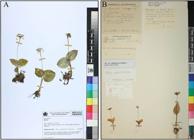
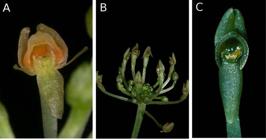
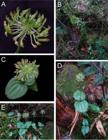
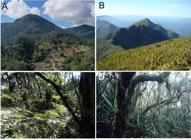

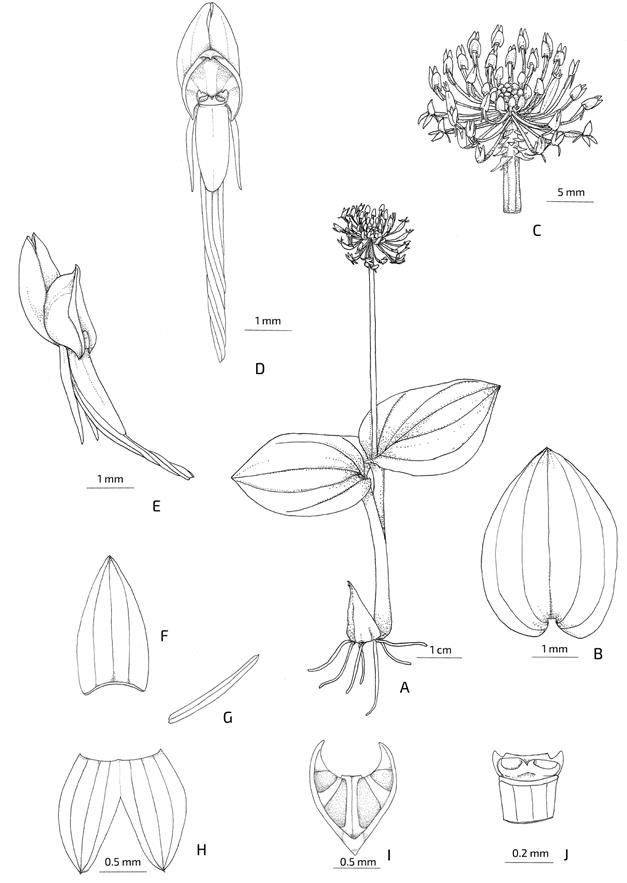 Illustration by L.K.R. Hinoshita, based on the holotype, spirit material, and photographs.A. Habit. B. Leaf blade. C. Inflorescence. D. Frontal view of the flower attached to the pedicel. E. Lateral view of the flower attached to the pedicel. F. Dorsal petal. G. Petal. H. Connate lateral sepal. I. Lip. J. Column.
Illustration by L.K.R. Hinoshita, based on the holotype, spirit material, and photographs.A. Habit. B. Leaf blade. C. Inflorescence. D. Frontal view of the flower attached to the pedicel. E. Lateral view of the flower attached to the pedicel. F. Dorsal petal. G. Petal. H. Connate lateral sepal. I. Lip. J. Column.
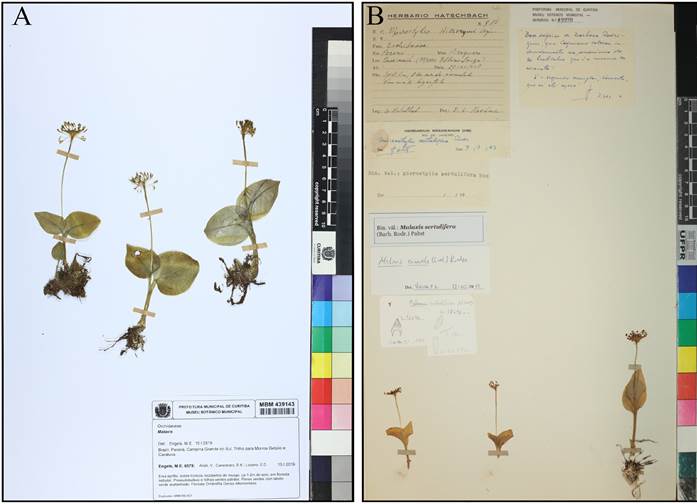 A. Holotype (MBM 439143). B. Paratype (MBM 49978).
A. Holotype (MBM 439143). B. Paratype (MBM 49978).
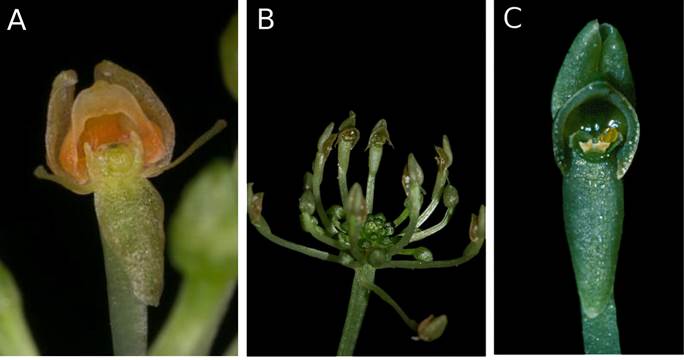 Photographs by Eric de Camargo Smidt (A) and João Aguiar Nogueira Batista (B-C).A. Flower of M. engelsii; it is possible to observe the longitudinal keel on the adaxial surface of the lip apex and the acute column wings. B. Inflorescence of M. sertulifera; low density in flower numbers. C. Flower of M. sertulifera; it is possible to observe the column with rounded wings and the acuminate lateral lobes of the lip.
Photographs by Eric de Camargo Smidt (A) and João Aguiar Nogueira Batista (B-C).A. Flower of M. engelsii; it is possible to observe the longitudinal keel on the adaxial surface of the lip apex and the acute column wings. B. Inflorescence of M. sertulifera; low density in flower numbers. C. Flower of M. sertulifera; it is possible to observe the column with rounded wings and the acuminate lateral lobes of the lip.
 Photographs by M. Engels.A. Inflorescence viewed from the side. B. Population of M. engelsii near a stream. C. Inflorescence viewed from above. D. Zoom in on an individual of M. engelsii epiphyte at the base of the host plant. E. Zoom in on the epiphytic population of M. engelsii.
Photographs by M. Engels.A. Inflorescence viewed from the side. B. Population of M. engelsii near a stream. C. Inflorescence viewed from above. D. Zoom in on an individual of M. engelsii epiphyte at the base of the host plant. E. Zoom in on the epiphytic population of M. engelsii.
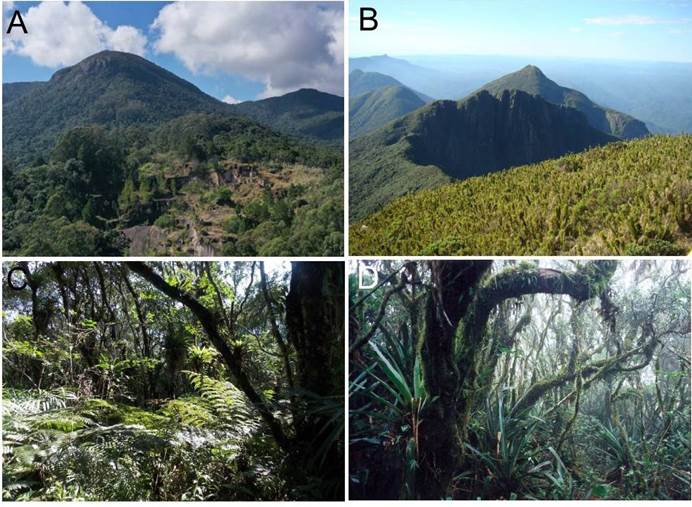 Photographs by Marcos Klingelfus (A, C) and Rodrigo de Andrade Kersten (B, D).A. Baitaca Mountain range. B. Ibitiraquire mountain range. C. Cloud Forest within Baitaca; abundant epiphytes. D. Cloud Forest within Ibitiraquire; abundant epiphytes.
Photographs by Marcos Klingelfus (A, C) and Rodrigo de Andrade Kersten (B, D).A. Baitaca Mountain range. B. Ibitiraquire mountain range. C. Cloud Forest within Baitaca; abundant epiphytes. D. Cloud Forest within Ibitiraquire; abundant epiphytes.